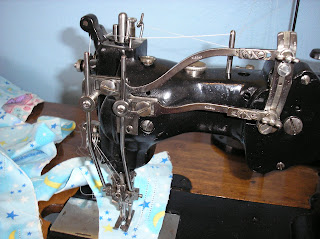Every time I sit down to stitch blankets on the hemstitcher, I cave and try to adjust it. The left needle thread continues to break despite everything I have done. One commenter suggested I move the main piercer either up/down or left/right. While I attempted to do this, I discovered that the main piercer holder was loose. Is it possible that the main piercer holder was vibrating or moving as a stitch is formed? It could explain why I could stitch a few inches and then the left thread would break randomly. The holder was only marginally lose but I could moved it ever so slightly with my finger.
So I attempted to tighten the screw on the holder. I wrenched down on the screw and shouldn't have done that. After all it is a 70 year old screw. And yes, the screw broke.

So I attempted to tighten the screw on the holder. I wrenched down on the screw and shouldn't have done that. After all it is a 70 year old screw. And yes, the screw broke.

There is a broken part of the screw stuck in the machine. Thankfully, I was able to locate a new screw. One nice thing about the old Singers is that the engineers used as many of the same parts in multiple machines as they could, especially screws. The problem, of course, is extracting the screw. I zoomed in pretty close in the picture above, but that screw opening is only about 1/8 inch. I am very nervous about doing this because I have to be very, very careful to not damage the threads of the piercer holder. That part will be very difficult and expensive to find, if at all. I probably will buy a Dremel as I don't trust myself with my regular drill. I don't know.
I am my own mechanic when it comes to repairing my Singer Hemstitcher 72w-19. There are very few mechanics familiar enough with this machine that I would trust them to work on it. I have really spent a lot of time studying it and I think I now understand how all the important parts work. The movement of the piercer thread holder as it stitches proves that it can break or cut the threads. It moves much more now that the screw is not completely there.
And of course this happened at a time when I have two large blanket orders. Thankfully, my customers are willing to wait. But if I can't fix it, then I will be taking these blankets to one of my competitors to finish. I am a bit stressed about the whole thing.
I am my own mechanic when it comes to repairing my Singer Hemstitcher 72w-19. There are very few mechanics familiar enough with this machine that I would trust them to work on it. I have really spent a lot of time studying it and I think I now understand how all the important parts work. The movement of the piercer thread holder as it stitches proves that it can break or cut the threads. It moves much more now that the screw is not completely there.
And of course this happened at a time when I have two large blanket orders. Thankfully, my customers are willing to wait. But if I can't fix it, then I will be taking these blankets to one of my competitors to finish. I am a bit stressed about the whole thing.



